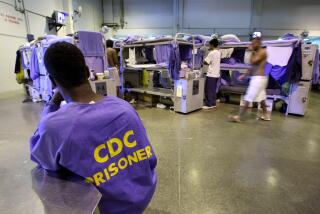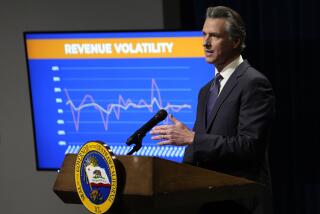Easy Does It With ‘Surplus’
- Share via
State government is about to reap another bonanza from the boisterous California economy. The figure won’t be known until mid-May, but Legislative Analyst Elizabeth G. Hill estimated Friday it will be as much as $4 billion. Now the rush is on to spend this “surplus” on new goodies. Republicans want a massive tax cut and Democrats hope to launch new or expanded programs.
But to call this money a surplus can be misleading. Basically, it is the amount of state revenues expected above the conservative level that was forecast in Gov. Gray Davis’ $78-billion budget submitted in January. It is an estimate based on this year’s revenues and what the experts think the economy will do in the fiscal year starting July 1.
The first rule in dealing with any surplus should be to refrain from committing it all to permanent spending programs or tax reductions. No one can know whether such good fortune will persist into future years. If revenues decline, state programs will have to be cut to close the gap.
The concept of surplus disappears altogether if viewed from the standpoint of state needs. First, Davis’ budget was balanced on some iffy assumptions, including the expectation of $430 million in new federal aid and $562 million from the tobacco industry lawsuit settlement. Congress never gave the state all it wanted in the past, and there is no certainty that the first payment from the tobacco agreement will be made in full this year.
On the spending side, Davis’ budget overlooked some critical needs, including funds for maintenance and repair of a severely dilapidated state park system. There was not enough money to finance the pay raises that state employees are expecting. And the budget shorted local government by at least $150 million in long-promised funds. Furthermore, Davis’ budget allowed for a cash reserve of only $415 million, far less than is prudent to meet emergencies.
The state budget actually would be in the red if you counted the money slashed from state programs during the recession, funding that has never been restored. The state still owes cities and counties the huge sums in property taxes that it took from them, at a rate of $1 billion a year, to balance its own budget in the early 1990s. And those salivating to spend this year must consider that Davis will want to put some of the new revenues into education, which he has declared his first priority.
Tax cuts get a low priority when balanced against other urgent needs, such as repair and reconstruction of the infrastructure. Besides, Californians already are enjoying $3.5 billion in tax cuts approved over the last several years. Senate Republicans have a program that shows some merit; included is a proposal to direct most of the receipts from the state’s gasoline sales tax to transportation projects. Pay-as-you-go funding is more effective than issuing costly bonds.
The governor should also take a close look at the senators’ proposal to return at least $150 million in property tax revenues to local government.
Davis will reveal his Finance Department’s own estimate of the “surplus” when he submits a revised budget to the Legislature on Friday. Whatever the figure, this money should not be treated as a happy windfall to be spent to best political advantage. It should be guarded carefully and invested selectively to held build a stronger, better California.
More to Read
Get the L.A. Times Politics newsletter
Deeply reported insights into legislation, politics and policy from Sacramento, Washington and beyond. In your inbox twice per week.
You may occasionally receive promotional content from the Los Angeles Times.










